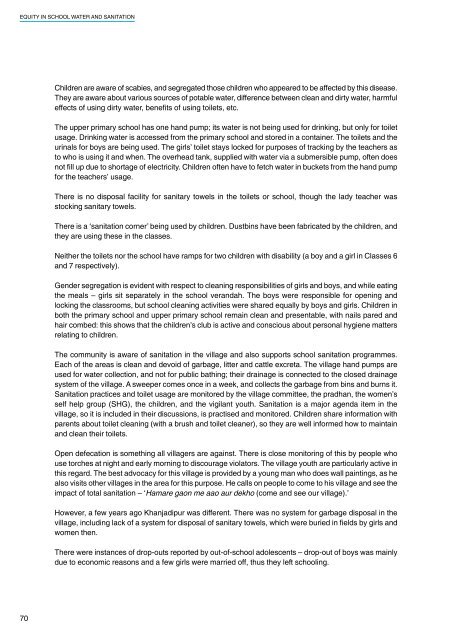Equity in School Water and Sanitation
Equity in School Water and Sanitation
Equity in School Water and Sanitation
Create successful ePaper yourself
Turn your PDF publications into a flip-book with our unique Google optimized e-Paper software.
EQUITY IN SCHOOL WATER AND SANITATIONChildren are aware of scabies, <strong>and</strong> segregated those children who appeared to be affected by this disease.They are aware about various sources of potable water, difference between clean <strong>and</strong> dirty water, harmfuleffects of us<strong>in</strong>g dirty water, benefits of us<strong>in</strong>g toilets, etc.The upper primary school has one h<strong>and</strong> pump; its water is not be<strong>in</strong>g used for dr<strong>in</strong>k<strong>in</strong>g, but only for toiletusage. Dr<strong>in</strong>k<strong>in</strong>g water is accessed from the primary school <strong>and</strong> stored <strong>in</strong> a conta<strong>in</strong>er. The toilets <strong>and</strong> theur<strong>in</strong>als for boys are be<strong>in</strong>g used. The girls’ toilet stays locked for purposes of track<strong>in</strong>g by the teachers asto who is us<strong>in</strong>g it <strong>and</strong> when. The overhead tank, supplied with water via a submersible pump, often doesnot fill up due to shortage of electricity. Children often have to fetch water <strong>in</strong> buckets from the h<strong>and</strong> pumpfor the teachers’ usage.There is no disposal facility for sanitary towels <strong>in</strong> the toilets or school, though the lady teacher wasstock<strong>in</strong>g sanitary towels.There is a ‘sanitation corner’ be<strong>in</strong>g used by children. Dustb<strong>in</strong>s have been fabricated by the children, <strong>and</strong>they are us<strong>in</strong>g these <strong>in</strong> the classes.Neither the toilets nor the school have ramps for two children with disability (a boy <strong>and</strong> a girl <strong>in</strong> Classes 6<strong>and</strong> 7 respectively).Gender segregation is evident with respect to clean<strong>in</strong>g responsibilities of girls <strong>and</strong> boys, <strong>and</strong> while eat<strong>in</strong>gthe meals – girls sit separately <strong>in</strong> the school ver<strong>and</strong>ah. The boys were responsible for open<strong>in</strong>g <strong>and</strong>lock<strong>in</strong>g the classrooms, but school clean<strong>in</strong>g activities were shared equally by boys <strong>and</strong> girls. Children <strong>in</strong>both the primary school <strong>and</strong> upper primary school rema<strong>in</strong> clean <strong>and</strong> presentable, with nails pared <strong>and</strong>hair combed: this shows that the children’s club is active <strong>and</strong> conscious about personal hygiene mattersrelat<strong>in</strong>g to children.The community is aware of sanitation <strong>in</strong> the village <strong>and</strong> also supports school sanitation programmes.Each of the areas is clean <strong>and</strong> devoid of garbage, litter <strong>and</strong> cattle excreta. The village h<strong>and</strong> pumps areused for water collection, <strong>and</strong> not for public bath<strong>in</strong>g; their dra<strong>in</strong>age is connected to the closed dra<strong>in</strong>agesystem of the village. A sweeper comes once <strong>in</strong> a week, <strong>and</strong> collects the garbage from b<strong>in</strong>s <strong>and</strong> burns it.<strong>Sanitation</strong> practices <strong>and</strong> toilet usage are monitored by the village committee, the pradhan, the women’sself help group (SHG), the children, <strong>and</strong> the vigilant youth. <strong>Sanitation</strong> is a major agenda item <strong>in</strong> thevillage, so it is <strong>in</strong>cluded <strong>in</strong> their discussions, is practised <strong>and</strong> monitored. Children share <strong>in</strong>formation withparents about toilet clean<strong>in</strong>g (with a brush <strong>and</strong> toilet cleaner), so they are well <strong>in</strong>formed how to ma<strong>in</strong>ta<strong>in</strong><strong>and</strong> clean their toilets.Open defecation is someth<strong>in</strong>g all villagers are aga<strong>in</strong>st. There is close monitor<strong>in</strong>g of this by people whouse torches at night <strong>and</strong> early morn<strong>in</strong>g to discourage violators. The village youth are particularly active <strong>in</strong>this regard. The best advocacy for this village is provided by a young man who does wall pa<strong>in</strong>t<strong>in</strong>gs, as healso visits other villages <strong>in</strong> the area for this purpose. He calls on people to come to his village <strong>and</strong> see theimpact of total sanitation – ‘Hamare gaon me aao aur dekho (come <strong>and</strong> see our village).’However, a few years ago Khanjadipur was different. There was no system for garbage disposal <strong>in</strong> thevillage, <strong>in</strong>clud<strong>in</strong>g lack of a system for disposal of sanitary towels, which were buried <strong>in</strong> fields by girls <strong>and</strong>women then.There were <strong>in</strong>stances of drop-outs reported by out-of-school adolescents – drop-out of boys was ma<strong>in</strong>lydue to economic reasons <strong>and</strong> a few girls were married off, thus they left school<strong>in</strong>g.70












